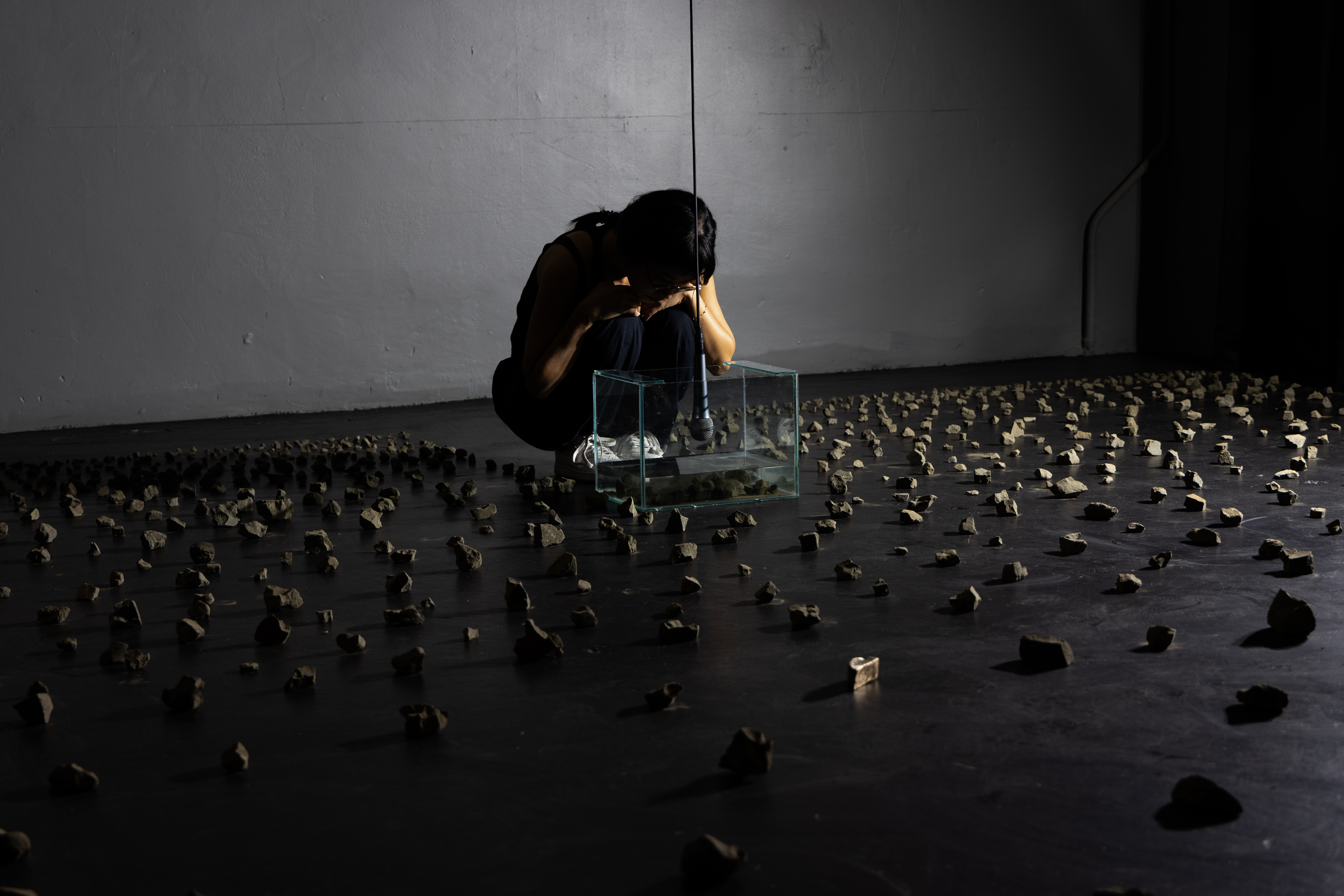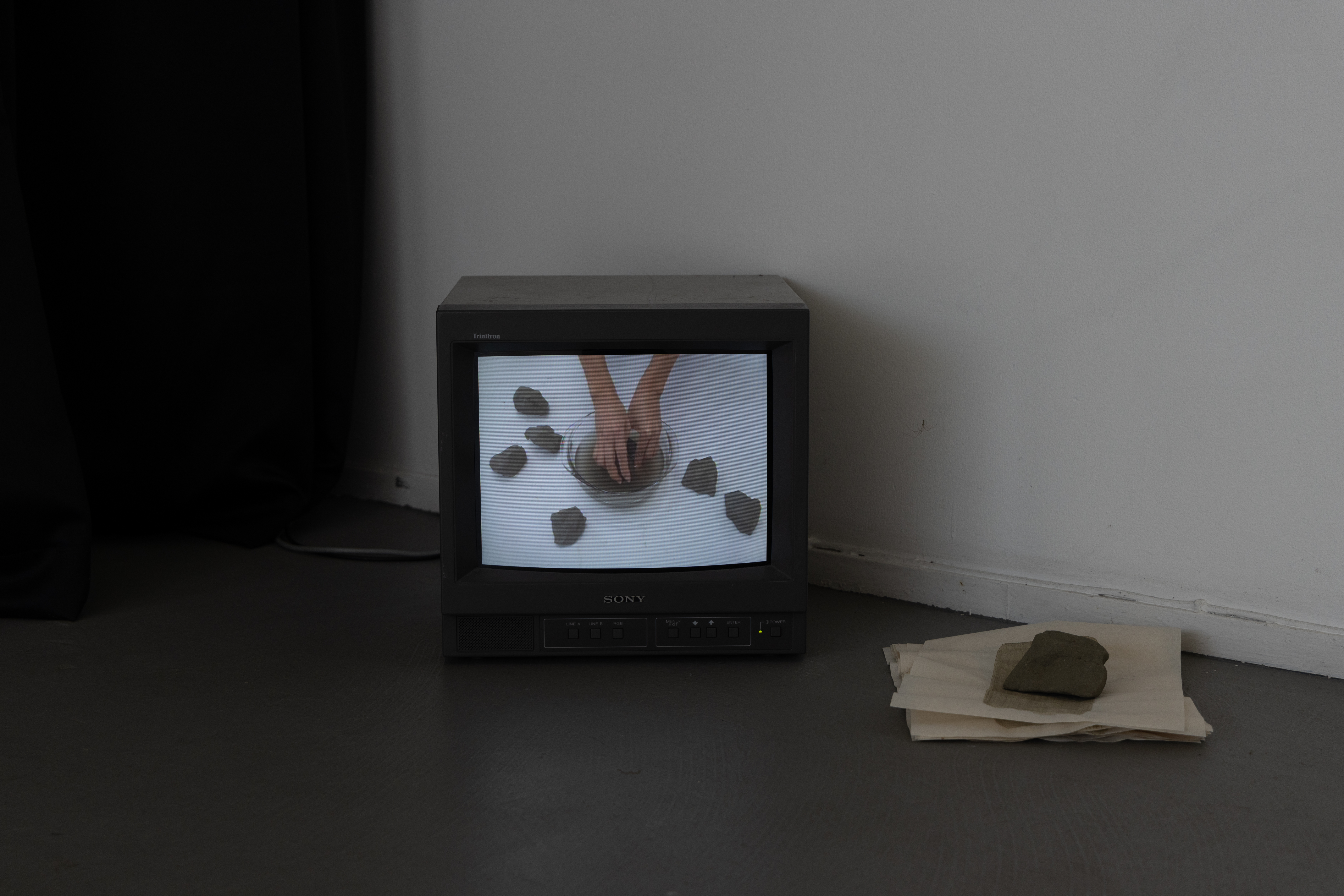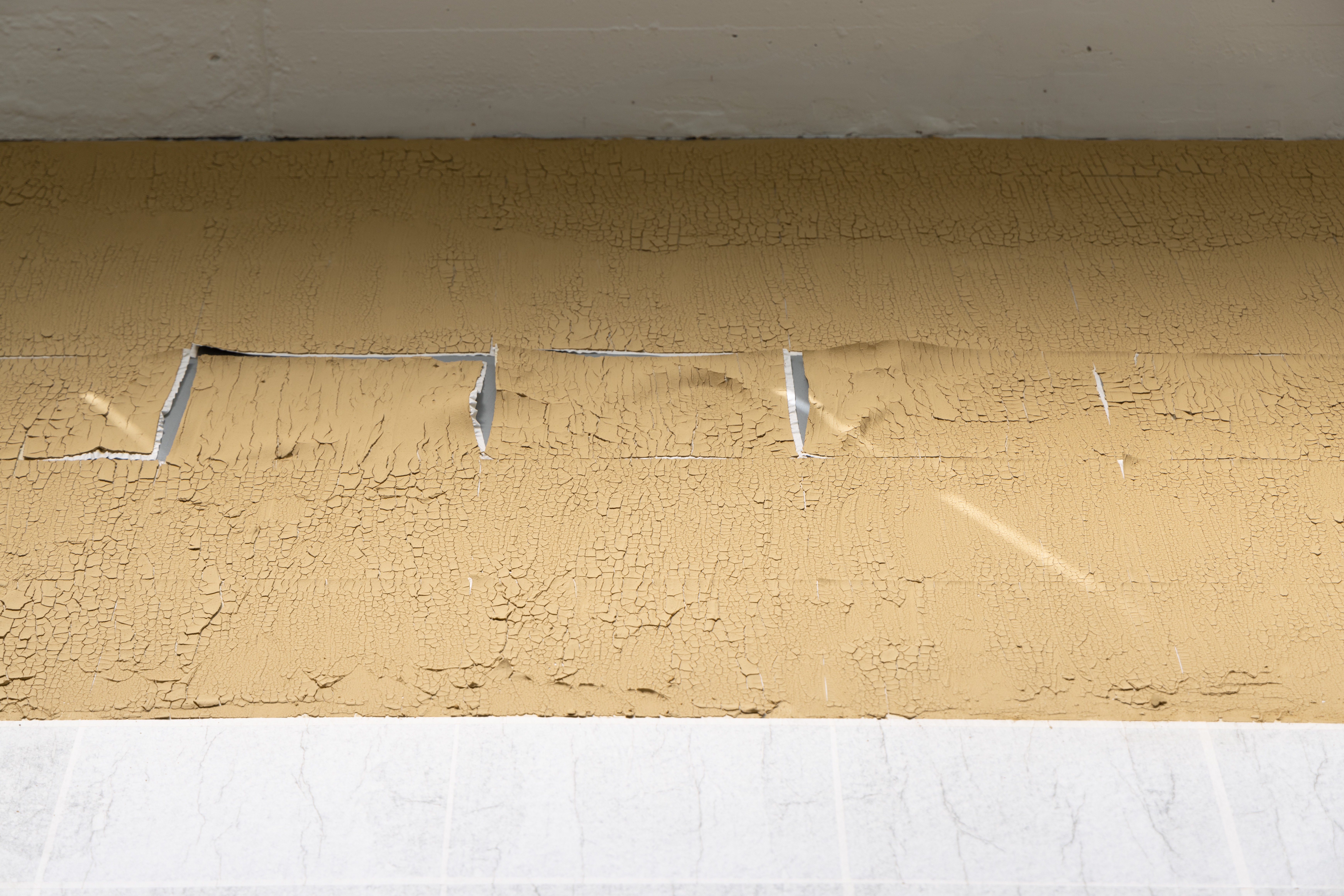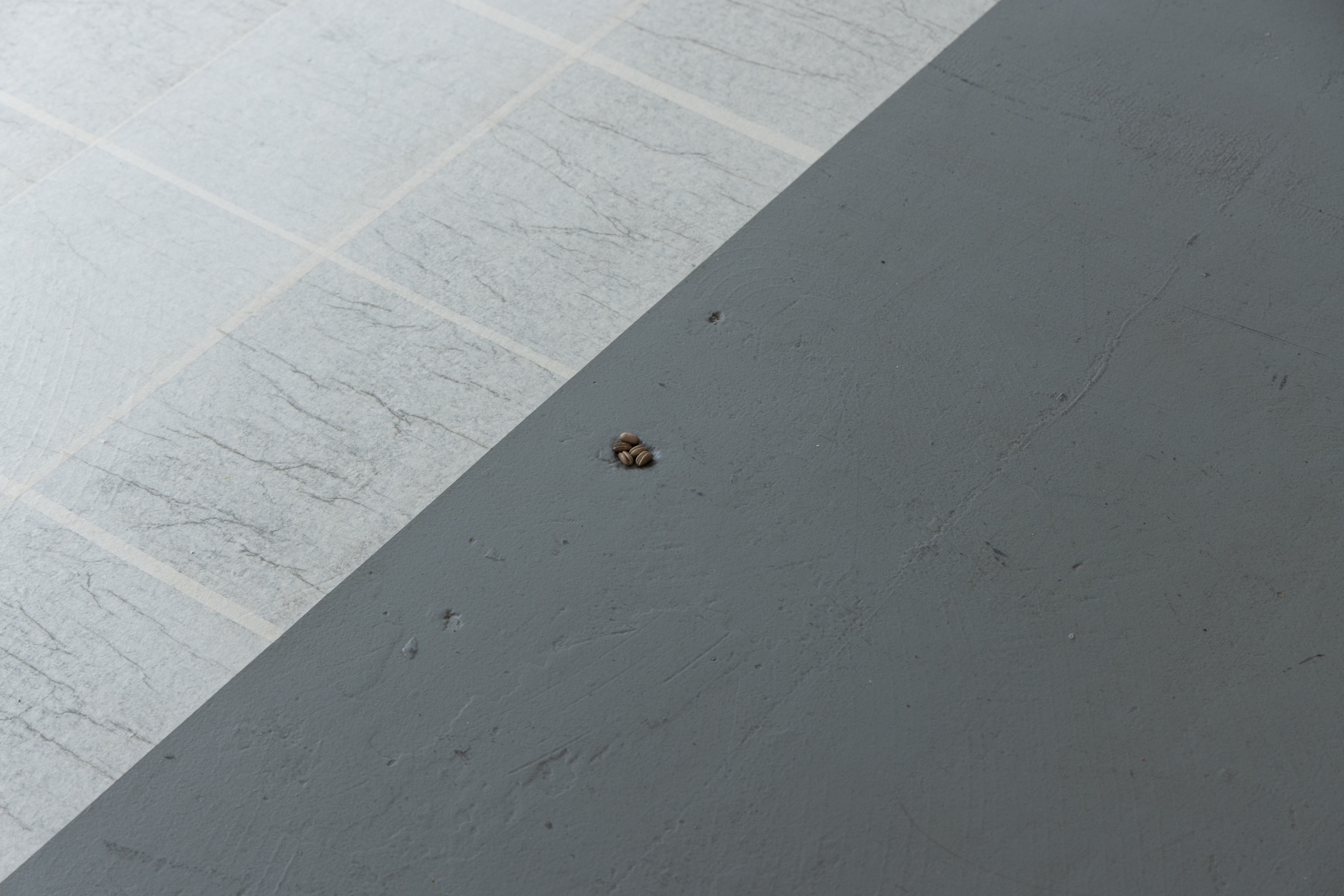
Up from, beyond the.
Touching Time by Yukari 海堀 Kaihori
Touching Time | Yukari Kaihori | Audio Foundation Gallery, Tāmaki Makaurau
30.12.22 | written by J. A. Kennedy
Avoiding my own two feet, not tripping down the stairs, I make an effort to consider each descending step in a dance of diligence. How far back, how deep, must one go to find common ground? Who is still here to convene at that fraction of a millisecond to midnight where potentials unravel?
In the final chapter of The Overstory, Richard Powers frames learning patterns of artificial intelligence as a sequence of events; moments that inevitably lead to a hyperreality experienced by unaware as well as aware human contributors. To introduce the chapter, Powers poses the thought: what if the existence of this planet was compressed into a day?1 With this question making millenia tangible, I’m left wondering, at what hour would lithification set in, sediments fusing into rockforms, at what hour would seasons begin informing seeds to drop, or the kākā to sing, and at which ten thousandth of a millisecond to midnight would excavation start and someone begin to listen?
At this moment, how might one encapsulate, with words, an artist's site specific practice that readily embodies relations to the often indescribable, disregarded, unseen, the more-than-human world?
Presented by the Audio Foundation gallery (AFG), Yukari Kaihori’s most recent solo exhibition, Touching Time, takes the opportunity to explore sound alongside the kinds of commonplace objects we have come to identify with the artist’s practice. Located at the South end of Myers Park, in the central city of Tāmaki Makaurau, the gallery is made up of several rooms and situated in what feels like an underground space, but in truth it sits at the top of the park's meandering path. From here Yukari is well positioned to question what structures lie in obscurity within the ecology of the park, not just beneath our immediate step, but 26 metres below, where the City Rail Link tunnel excavation has begun.
Situated within the front and back exhibition rooms of AFG, Touching Time is an examination of what is unseen, but currently happening beneath our feet. The exhibition continues Yukari’s practice of connecting herself, as well as a willing audience, to multisensory aspects of a site of inquiry. Using found materials alongside those typically incorporated within her recent work (bronze, Japanese calligraphy paper), Yukari’s response is composed of two distinct works, describable as instrumental sets in the way that they are composed of parts, which make up a larger whole. In the hall, between each room, is the materials list alongside a selection of documentation and graphs relating to the tunnel excavations.
In the final chapter of The Overstory, Richard Powers frames learning patterns of artificial intelligence as a sequence of events; moments that inevitably lead to a hyperreality experienced by unaware as well as aware human contributors. To introduce the chapter, Powers poses the thought: what if the existence of this planet was compressed into a day?1 With this question making millenia tangible, I’m left wondering, at what hour would lithification set in, sediments fusing into rockforms, at what hour would seasons begin informing seeds to drop, or the kākā to sing, and at which ten thousandth of a millisecond to midnight would excavation start and someone begin to listen?
At this moment, how might one encapsulate, with words, an artist's site specific practice that readily embodies relations to the often indescribable, disregarded, unseen, the more-than-human world?
Presented by the Audio Foundation gallery (AFG), Yukari Kaihori’s most recent solo exhibition, Touching Time, takes the opportunity to explore sound alongside the kinds of commonplace objects we have come to identify with the artist’s practice. Located at the South end of Myers Park, in the central city of Tāmaki Makaurau, the gallery is made up of several rooms and situated in what feels like an underground space, but in truth it sits at the top of the park's meandering path. From here Yukari is well positioned to question what structures lie in obscurity within the ecology of the park, not just beneath our immediate step, but 26 metres below, where the City Rail Link tunnel excavation has begun.
Situated within the front and back exhibition rooms of AFG, Touching Time is an examination of what is unseen, but currently happening beneath our feet. The exhibition continues Yukari’s practice of connecting herself, as well as a willing audience, to multisensory aspects of a site of inquiry. Using found materials alongside those typically incorporated within her recent work (bronze, Japanese calligraphy paper), Yukari’s response is composed of two distinct works, describable as instrumental sets in the way that they are composed of parts, which make up a larger whole. In the hall, between each room, is the materials list alongside a selection of documentation and graphs relating to the tunnel excavations.

First Room
Sandstone excavated from Beresford Square (East Coast Bay formation)
Two Bronze works
Aquarium
Dynamic Microphone.
Sandstone excavated from Beresford Square (East Coast Bay formation)
Two Bronze works
Aquarium
Dynamic Microphone.
I enter, arriving at the darkened front room, where a single flood light is positioned on a yellow stand looking over the installation. I mirror this stance of inquisition. Laid out on the floor, is an arrangement of stones in a grid descending in size, leading around to a path that allows access to a central perspex box filled with water. Above the clear box is a hanging microphone, linked to two speakers installed on the adjacent wall just above head height. Is this evidence of Yukari touching, looking, listening, smelling, tasting time? A statement, invitation, or instruction?
Yukari has dedicated the space to provide a platform for fragments of East Coast Bay formation sandstone, as specified in the works list, to release air. Yukari invites a sympathetic viewer to place the 17 million year old stones into the water and listen to the pop pip sounds of their untold story. Amongst the fragments are two bronze casts: the first taken from an indent in the floor; the second from a single stone sample provided upon request by the City Rail Link.2 Here we see, exposed, Yukari’s interest in presenting pluralistic perspectives, where supporting documentation from geological engineers' notations and graphs are as rooted in the exhibition as the cast bronze indent or stone. With AFG as a viewing platform to listen and inquire from, are these additions to the found materials wayfinders? A reminder of Yukari’s consideration of place?
Site response is Yukari's way to actively become witness to the more-than-human world. In their 2017 essay, professors Deborah Bird Rose and Thom van Dooren outline what it means to encounter a world as a witness, acknowledging ways of life, customary practices and places.3 This is precedent for Yukari to spend time with material fragments from a site such as Myers Park. The bronze casting (indents, stones, Phoenix palm seeds) is itself an engagement with a way of life, a customary practice of remembering the significance that common natural objects hold in relation to a place. I participate by soaking four stones, patiently waiting to hear a murmur, an expectation my surroundings will perform at my own will. I rely on the rate of translation—water soaks, air exits, a bubble appears—to instigate dialogue. Here, the sounds that typically escape us are not only amplified and heard, but sought out.
The excavated stones are stagnant, inanimate, inactive at our time scale, and are waiting to be heard. But by compressing all time into a single day we might see the process of lithification happening, visible, tangible. The artist facilitates a means to see and listen, to describe invisible and silent-to-the-human-ear phenomena occurring in our natural world. However rhetorical that output might be, the result can be understood as an honouring of these objects through the act of being present.
I remember stumbling past single bronze Phoenix palm seeds, their presence staggered on the corner of each step leading down to the gallery's entrance. These representational seeds are unable to speak as the stones do. They embody the potential of a hopeful palm that has been sequestered. Now placed as a static sculpture, they are kicked or nicked, escaping definition.
Yukari has dedicated the space to provide a platform for fragments of East Coast Bay formation sandstone, as specified in the works list, to release air. Yukari invites a sympathetic viewer to place the 17 million year old stones into the water and listen to the pop pip sounds of their untold story. Amongst the fragments are two bronze casts: the first taken from an indent in the floor; the second from a single stone sample provided upon request by the City Rail Link.2 Here we see, exposed, Yukari’s interest in presenting pluralistic perspectives, where supporting documentation from geological engineers' notations and graphs are as rooted in the exhibition as the cast bronze indent or stone. With AFG as a viewing platform to listen and inquire from, are these additions to the found materials wayfinders? A reminder of Yukari’s consideration of place?
Site response is Yukari's way to actively become witness to the more-than-human world. In their 2017 essay, professors Deborah Bird Rose and Thom van Dooren outline what it means to encounter a world as a witness, acknowledging ways of life, customary practices and places.3 This is precedent for Yukari to spend time with material fragments from a site such as Myers Park. The bronze casting (indents, stones, Phoenix palm seeds) is itself an engagement with a way of life, a customary practice of remembering the significance that common natural objects hold in relation to a place. I participate by soaking four stones, patiently waiting to hear a murmur, an expectation my surroundings will perform at my own will. I rely on the rate of translation—water soaks, air exits, a bubble appears—to instigate dialogue. Here, the sounds that typically escape us are not only amplified and heard, but sought out.
The excavated stones are stagnant, inanimate, inactive at our time scale, and are waiting to be heard. But by compressing all time into a single day we might see the process of lithification happening, visible, tangible. The artist facilitates a means to see and listen, to describe invisible and silent-to-the-human-ear phenomena occurring in our natural world. However rhetorical that output might be, the result can be understood as an honouring of these objects through the act of being present.
I remember stumbling past single bronze Phoenix palm seeds, their presence staggered on the corner of each step leading down to the gallery's entrance. These representational seeds are unable to speak as the stones do. They embody the potential of a hopeful palm that has been sequestered. Now placed as a static sculpture, they are kicked or nicked, escaping definition.

Second Room
Video, Washing of a Sandstone
Japanese calligraphy paper with clay from the East Coast Bay formation
Phoenix palm seeds bronze
Floor print bronze
Bronze cast from gallery floor
Petri Dishes with Phoenix palm seeds and bronze Phoenix palm seeds.
Video, Washing of a Sandstone
Japanese calligraphy paper with clay from the East Coast Bay formation
Phoenix palm seeds bronze
Floor print bronze
Bronze cast from gallery floor
Petri Dishes with Phoenix palm seeds and bronze Phoenix palm seeds.
Moving into the light, the second room contains a television box playing a looped single-channel video. An action of undoing; Yukari is gently washing a single fragment of sandstone in a bowl of water, turning the sandstone back into loose sand. I see this video as the key linking the two rooms, the two works. It is a performance that documents the artist both as witness and active participant, inviting the same of us.
Placed next to the video is a pile of Japanese calligraphy paper with a washed stone placed on top. The visible pages are marked with the loosened sand applied in a single layer. Yukari is not only drawing from recent more-than-human scholarship, but also from Shinto Japanese traditions relating to respect and an understanding that objects, regularly deemed to be inanimate in western cultures, are (or were) alive and part of a non-hierarchical structure.4 In this room, Yukari has spent time with sandstone, clay, and Phoenix palm seeds. It is here, in this instance, that their purpose and role in the natural world are presented through exhibition, an acknowledgment service before they continue on their yet undetermined trajectory.
To my left I find one more indent bronze cast, again a reminder to stop and consider where I stand. At my feet is more calligraphy paper pasted on the ground, a third of which is smeared with excavated clay from the East Coast Bay formation. After conversations with Yukari, I understand this composition is to further reflect an interest in material ontology. Where the agency of things, existing in relation to each other, comes in contact with our own. This particular set is placed in a manner that prompts an audience to engage by walking on the surface to get a better look, asking, what is being examined? With eyes or with ears? In order to get a better look at bronze cast Phoenix palm seeds carefully placed on cotton swab cushions in petri dishes on the window ledge, I stand on the clay-smeared paper. An obligatory engagement, both looking at the objects and listening to the dry crunch of clay underfoot.
Placed next to the video is a pile of Japanese calligraphy paper with a washed stone placed on top. The visible pages are marked with the loosened sand applied in a single layer. Yukari is not only drawing from recent more-than-human scholarship, but also from Shinto Japanese traditions relating to respect and an understanding that objects, regularly deemed to be inanimate in western cultures, are (or were) alive and part of a non-hierarchical structure.4 In this room, Yukari has spent time with sandstone, clay, and Phoenix palm seeds. It is here, in this instance, that their purpose and role in the natural world are presented through exhibition, an acknowledgment service before they continue on their yet undetermined trajectory.
To my left I find one more indent bronze cast, again a reminder to stop and consider where I stand. At my feet is more calligraphy paper pasted on the ground, a third of which is smeared with excavated clay from the East Coast Bay formation. After conversations with Yukari, I understand this composition is to further reflect an interest in material ontology. Where the agency of things, existing in relation to each other, comes in contact with our own. This particular set is placed in a manner that prompts an audience to engage by walking on the surface to get a better look, asking, what is being examined? With eyes or with ears? In order to get a better look at bronze cast Phoenix palm seeds carefully placed on cotton swab cushions in petri dishes on the window ledge, I stand on the clay-smeared paper. An obligatory engagement, both looking at the objects and listening to the dry crunch of clay underfoot.


Second Room.
Looking out, I see Myers Park, completed in 1915, as an archive itself, the original sparsely planted tropical concourse, a hyperreality of exotic flora laid out by Thomas Edward Pearson F.R.H.S (1857-1930). Pearsons drew inspiration for his landscaping from an attitude to create a world within a world, his hand presiding over nature and its own structures. With an interest in bringing flora together from various parts of the world to pair with what was present at hand, Pearson created unsympathetic hyperreal environments separated from a natural cycle. Myers Park as an example of human control. In this moment, at a fraction of a millisecond to midnight, Touching Time acknowledges this fractured cycle. Avoiding the need to hold on too tight and overtly define a narrative, Yukari acts in a manner that instigates and aids connection with what is typically overlooked, cautiously questioning and listening to hear a voice physically held within the earth’s crust.
Yukari’s intentions confront a world without phenomenal existence, taking time to visualise time scales and systems that overlap out of sight as well as earshot. Yukari’s sensitive contemplation of materials exposes the past in the present, weaving a narrative usually held in silence as would the playful rhizomatic system of a towering palm. Sympathetically, Yukari presents us with a choice: to look, listen, smell, taste, touch—or not. This effort brings forward the seemingly inconceivable, the invisible everyday, placing it in view. Using exhibition as a means of sharing notation, Yukari presents a framework that allows considerations to expand past the four walls of expectation.
In the end I say goodbye; with only memories of the original artwork intact. The borrowed material now returned to the City Rail Link’s site sustainability team, who will undertake their own standard processing procedures. After 17 million years, I walk away having been given the opportunity to witness the voices of four stones. Stones who will live out future potentials in silence, with voices returned to time.
Yukari Kaihori, Touching Time, 2022. 20 October – 16 November at Audio Foundation, Tāmaki Makaurau.
Photos: By Grant Priest. Courtesy of the artist and Audio Foundation.
Works are titled based on work descriptions. All works made 2022 by Yukari Kaihori.

Article image: First Room. Photo: Grant Priest.
1. Powers, R. (2018) The Overstory, Vintage/Penguin Random House, London. 591-592.
2. “University of Auckland Environmental Department… have confirmed the material as being 17-21 million year old sandstone belonging to the East Coast Bay formation.” Sourced from the artist's statement.
3. Rose, D. and T. van Dooren (2017) ‘Encountering a More-than-human World: Ethos and the Arts of Witness’, in Ursula Heise, Jon Cristensen and Michelle Niemann (eds.) Routledge Companion to the Environmental Humanities, Routledge: London, 120-128.
4. Email conversation with Yukari Kaihori, 10th November 2022.
Yukari’s intentions confront a world without phenomenal existence, taking time to visualise time scales and systems that overlap out of sight as well as earshot. Yukari’s sensitive contemplation of materials exposes the past in the present, weaving a narrative usually held in silence as would the playful rhizomatic system of a towering palm. Sympathetically, Yukari presents us with a choice: to look, listen, smell, taste, touch—or not. This effort brings forward the seemingly inconceivable, the invisible everyday, placing it in view. Using exhibition as a means of sharing notation, Yukari presents a framework that allows considerations to expand past the four walls of expectation.
In the end I say goodbye; with only memories of the original artwork intact. The borrowed material now returned to the City Rail Link’s site sustainability team, who will undertake their own standard processing procedures. After 17 million years, I walk away having been given the opportunity to witness the voices of four stones. Stones who will live out future potentials in silence, with voices returned to time.
Yukari Kaihori, Touching Time, 2022. 20 October – 16 November at Audio Foundation, Tāmaki Makaurau.
Photos: By Grant Priest. Courtesy of the artist and Audio Foundation.
Works are titled based on work descriptions. All works made 2022 by Yukari Kaihori.
Article image: First Room. Photo: Grant Priest.
1. Powers, R. (2018) The Overstory, Vintage/Penguin Random House, London. 591-592.
2. “University of Auckland Environmental Department… have confirmed the material as being 17-21 million year old sandstone belonging to the East Coast Bay formation.” Sourced from the artist's statement.
3. Rose, D. and T. van Dooren (2017) ‘Encountering a More-than-human World: Ethos and the Arts of Witness’, in Ursula Heise, Jon Cristensen and Michelle Niemann (eds.) Routledge Companion to the Environmental Humanities, Routledge: London, 120-128.
4. Email conversation with Yukari Kaihori, 10th November 2022.
ISSN 2744-7952
Thank you for reading ︎
Vernacular logo designed by Yujin Shin
vernacular.criticism ︎

